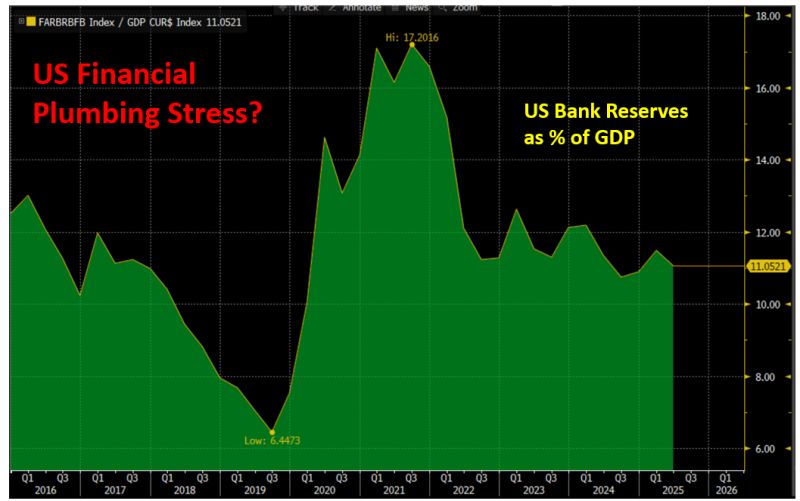5 big analyst AI moves: Apple lifted to Buy, AI chip bets reassessed
Is the US financial plumbing system under severe stress?
Last week, several pundits and financial media were all over the potential stress brewing in the US financial plumbing system.
Specifically, SOFR fixings have been several basis points above Fed Funds, which could indicate that repo markets are under stress as collateralized repo transactions (e.g,. SOFR) command an increasingly higher yield over pure proxies of risk-free rate (e.g., Fed Funds).
Before I give you my perspective, let’s recap: why would such pressure be building in the first place?
QT has operated in the background for a while, the RRP facility has been drained to virtually 0, and the TGA has been replenished: this trio of plumbing operations has led to bank reserves flirting with the 3 trillion level.
$3 trillion of reserves is an important level because it’s ~10% of US nominal GDP as per Q2. In a recent speech, Waller indicated 10% as the first threshold to define a regime of ‘’scarce reserves’’.
Reserves are money for banks – they are used to settle interbank transactions.
If reserves are scarce, banks will find it harder to oil the underlying mechanism supporting the base of the pyramid of financial markets: the US repo market.
The chart below shows how US bank reserves now represent 11% of US nominal GDP, close to the ’’Waller threshold’’.
But does that mean the financial plumbing system is under stress?
Not really.
One of the easiest ways to track plumbing stress is to look at the difference between 3-month ahead SOFR rates (proxy for US repo rate) and 3-month ahead Fed Funds rate (pure risk-free) - the SOFR/Fed Fund spread investors are expecting for the near future.
The spread sits at 8 bps today, hardly signaling any real underlying stress in the plumbing of financial markets.
And another barometer for US financial plumbing stress - swap spreads - is also behaving very well.
Powell also basically telegraphed the end of QT this week, so this is a risk the Fed is actively managing.
***
This article was originally published on The Macro Compass. Come join this vibrant community of macro investors, asset allocators and hedge funds - check out which subscription tier suits you the most using this link.
